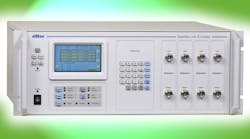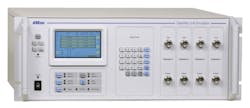Versatile Testers Emulate Satellite-Communications Links
This file type includes high resolution graphics and schematics when applicable.
The SLE line of Satellite Link Emulators features a touchscreen front panel for ease of use, along with a modular design that allows from one to four channels to be installed for flexible satellite link emulation.
Satellite-communications systems reach to orbiting satellites to provide reliable communications on Earth. They are subject to interference from the planet and other impairments that can challenge the performance and reliability, but regular testing helps avoid problems.
Testing a satellite-communications (satcom) system, however, requires a special kind of test instrument, one capable of recreating the signal path between a satellite and ground station. Addressing that need is a trio of Satellite Link Emulators (SLEs) from dBm Corp., which can recreate the multiple paths, noise, and distortion common to satcom systems, along with a choice of three bandwidths to suit most testing needs.
Designed for testing at satcom intermediate frequencies (IFs), models SLE9072, SLE90125, and SLE90250 are available, respectively, with 1-dB bandwidths of 72 MHz centered at either 70 or 140 MHz, 125 MHz centered at 140 MHz, and 250 MHz centered at 1200 MHz.
These satellite link emulators (see figure) are well-suited for testing Earth terminals and satellite payloads, as well as mobile transceivers. The firm offers both optional internal frequency converters for L-band coverage and compact external frequency converters to translate signals from the emulators to higher-frequency signals at L-, C-, S-, X-, Ku-, and Ka-bands.
The satcom testers use a combination of analog and digital components to achieve different signal effects. To create desired signal effects, such as Doppler shifts, added noise, and fading, signals on each channel are first demodulated into in-phase (I) and quadrature (Q) components. They are transformed into digital signals by means of a high-performance 12-b analog-to-digital converter (ADC).
It is in the digital realm where a digital signal processor (DSP) performs its magic, achieving Raleigh and Rician fading with as many as six paths per channel, precise amounts of additive white Gaussian noise (AWGN), and Doppler shifts.
The digitally processed signals are then converted back to the analog realm through a high-resolution, 16-b digital-to-analog converter (DAC), with I and Q modulation restored, noise removed through filtering, and frequency offsets added by means of a high-speed direct-digital synthesizer (DDS). Upconversion is applied to return the signals to their original IFs.
Each instrument includes generous internal flash memory to store digital representations of different signal scenarios. An Ethernet connection provides the means to download data files for signal emulation. Data files can run at playback rates from 1 to 1,000 Hz—whether in single steps, continuous loops, forward, or reverse—to emulate the many different conditions encountered in satcom systems.
The SLE instruments accept IF input signals at a maximum power level of 0 dBm, producing delayed and processed output signals at the same 0 dBm. The instruments will operate in static mode, where signal conditions are fixed, or in dynamic mode, with time-varying conditions according to programmed limits.
The typical noise floor for each instrument is −141 dBm/Hz. For the maximum bandwidth (250 MHz), the peak-to-peak amplitude ripple is typically 1.0 dB. For narrower bandwidths, the amplitude ripple is typically better than 0.5 dB.
The instruments provide delay ranges depending on bandwidths, with delays of 15 µs to 1,400 ms for a 72-MHz bandwidth and delays from 10 µs to 890 ms for 125- and 250-MHz bandwidths. Delays can be set with 0.1-ns resolution in static mode and with 0.5-ps/s resolution in dynamic mode. Frequency offsets are able to be set for a range of ±3 MHz with 0.01-Hz resolution.
Phase offsets can be added from 0 to 180 deg. with 1-deg. resolution and better than 1-deg. accuracy, while attenuation is adjustable from 0 to 70 dB with 0.1-dB resolution and ±0.2 dB accuracy. The attenuation can be varied over time, with a slew rate of greater than 70 dB/ms.
These are just a fraction of the capabilities of these three satellite link emulators. Modeling all characteristics of a satellite signal path is certainly not trivial. But the SLE line of emulators, with straightforward, touchscreen-based front panels—in combination with the firm’s SATGEN II satellite modeling software—can significantly cut the time required to create the test signals required for satcom system measurements.
The software, which runs on a standard PC or mobile computing device running Windows XP, 7, 8.1, or 10, can model signals for as many as eight transceivers for each channel. It is able to simulate signal conditions for fixed earth terminals, mobile vehicular transceivers, aircraft transceivers, and maritime satellite transceivers. The software can model any satellite orbit, and orchestrate the creation of data files for delays, path losses, Doppler shifts, and even atmospheric signal losses as a function of frequency, humidity, and temperature.
dBm Corp., 32A Spruce St., Oakland, NJ 07436; (201) 677-0008
This file type includes high resolution graphics and schematics when applicable.



